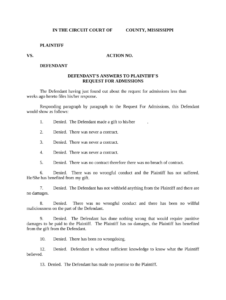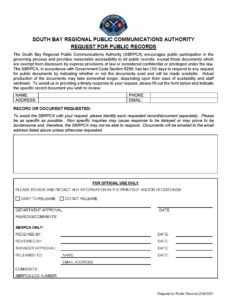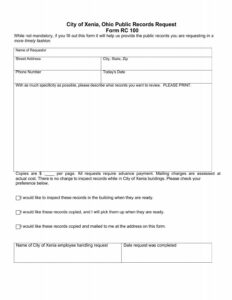Utilizing a standardized structure offers several advantages. It helps streamline the request process, reducing the likelihood of delays or misunderstandings. Clear and concise requests increase the efficiency of government agencies in locating and providing the desired information. Furthermore, using these forms can empower individuals by ensuring their requests adhere to legal requirements, maximizing the chances of obtaining the necessary records.
The following sections will explore the specifics of the Florida Public Records Act, offer guidance on completing these valuable forms, and provide resources for locating specific government agencies and their contact information.
Key Components of a Florida Public Records Request
Effective requests for public records in Florida require certain essential elements to ensure clarity and expedite processing. These components help agencies understand the specific information sought and comply with legal obligations.
1. Requester Information: Providing clear contact information, including a name, address, phone number, and email address, enables agencies to respond efficiently and provide updates on the request status.
2. Agency Identification: Correctly identifying the specific government agency holding the desired records is crucial for proper routing and timely processing. This includes the agency’s full name and, if possible, the specific department or division.
3. Detailed Description of Records: A precise and unambiguous description of the requested records is essential. Specificity regarding dates, individuals involved, subject matter, and document types (e.g., emails, reports, contracts) helps narrow the search and minimizes processing time. Vague or overly broad requests may be subject to clarification or narrowing.
4. Preferred Format: Specifying the desired format for receiving the records (e.g., electronic copies, paper copies) helps agencies prepare the information accordingly. This also helps manage costs associated with reproduction and delivery.
5. Method of Delivery: Indicating the preferred method of receiving the records (e.g., email, mail, pick-up) facilitates efficient delivery. This also allows requesters to anticipate when they might expect to receive the information.
6. Fee Acknowledgment: Florida law allows agencies to charge fees for copying, redacting, and other associated costs. Acknowledging the potential for fees ensures the requester understands and agrees to these charges, preventing delays due to billing disputes. Specifying a willingness to pay up to a certain amount can also be helpful.
7. Date and Signature (if applicable): While not always required, including a date and signature can add formality and demonstrate the seriousness of the request. Some agencies may specifically require a signature for certain types of requests.
Accurate and comprehensive requests facilitate the timely processing of public records and contribute to government transparency and public access to information. Clearly articulated requests benefit both requesters and the agencies responsible for fulfilling them.
How to Create a Florida Public Records Request
Creating a well-structured public records request increases the likelihood of a prompt and complete response from Florida government agencies. The following steps outline best practices for drafting effective requests.
1: Obtain a Template (Optional): While not mandatory, using a template can ensure all necessary elements are included. Many Florida government agencies and non-profit organizations offer downloadable templates. These pre-formatted forms can streamline the process and minimize errors.
2: Identify the Correct Agency: Determine the specific government entity holding the desired records. Florida has numerous state and local agencies, each responsible for different types of information. Consulting agency websites or directories can help identify the correct recipient.
3: Compose a Detailed Description: Clearly and concisely describe the specific records sought. Include relevant dates, names of individuals or entities involved, specific document types, and any other identifying information that can help narrow the search. Avoid vague or overly broad language.
4: Specify Preferred Format and Delivery Method: Indicate the preferred format for receiving the records (e.g., electronic, paper copies) and the desired delivery method (e.g., email, mail, pick-up). This helps agencies prepare the information accordingly and ensures efficient delivery.
5: Address Potential Fees: Acknowledge the potential for fees associated with processing the request, such as copying charges. Expressing willingness to pay reasonable fees demonstrates good faith and can expedite the process. Inquiring about estimated costs beforehand is advisable.
6: Include Contact Information: Provide complete and accurate contact information, including a name, address, phone number, and email address, to enable the agency to respond efficiently and provide updates on the request’s status.
7: Review and Submit: Carefully review the completed request for accuracy and completeness before submitting it to the designated agency contact. Following these steps increases efficiency, reduces processing time, and contributes to effective communication between requesters and government entities, ultimately fostering transparency and accountability.
Access to public records empowers citizens and strengthens accountability within government. Standardized forms for requesting these records in Florida provide a crucial framework for ensuring clarity, efficiency, and compliance with legal requirements. By understanding the components of a well-crafted request and following best practices for submission, individuals can effectively exercise their right to access government information.
Leveraging these tools contributes to a more informed citizenry and fosters greater transparency in the operation of government. Continued engagement with these processes is essential for upholding the principles of open government and ensuring public access to the information necessary for a thriving democracy.


